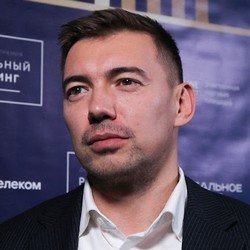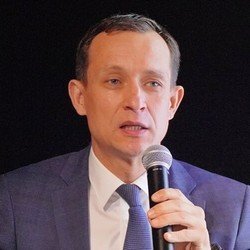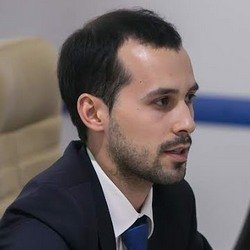‘Special designer’ from Artemy Lebedev’s studio makes logo for Tatarstan
2022 was declared the Year of Digitalisation in Tatarstan when more than 100 different events will take place, including the launch of the first e-passports in test mode. The logotype of the Year of Digitalisation made by famous designer Artemy Lebedev’s studio was presented in the Tatarstan National Library on 28 December. Before this, there was held a discussion about how modern smart cities should look like with Lebedev himself and Tatarstan Minister of Digital Development Ayrat Khayrullin. Read more in Realnoe Vremya’s report.
A smart city is a comfortable city
Ayrat Khayrullin noted that the process of urbanisation was inevitable, while the urban environment itself was a compromise for life, work and leisure time. Technologies have developed so much that a person can open Instagram in the morning and see what, for instance, Artemy Lebedev ate for breakfast but at the same time have no idea who lived next door. While some projects can be implemented in one’s courtyard if neighbours come together, the minister complained.
He thinks a lot of everyday processes can be digitalised. For instance, smart meters could send information to the management company themselves or the annual voting in the homeowner association could be online. Even road signs can be digital and regulate traffic depending on the traffic in the streets. Unmanned transport, rovers, or robot couriers, will appear in big cities soon, and architects should think about the appearance, attractiveness and comfort of cities.
Innopolis Mayor Ruslan Shagaleyev thinks that a smart city isn’t a city where all processes are automated but the one that is in dialogue with its citizens and changes together with their needs. It is a city “that will create conditions in which a citizen would feel necessary and in demand.” Vice chief architect of Kazan Timur Kadyrov supposes that digitalisation cannot be an end in itself. The objective for architects and urban engineers is to make a comfortable, committed city whose citizens would have access to different services.
Artemy Lebedev made his contribution to the discussion too. He claimed that he had never met either a smart city or a smart home. The market has a lot of solutions, but they all operate poorly. The designer said that he as a fan of digitalisation purchased an expensive electricity meter, but it doesn’t connect to Wi-Fi, therefore he receives the average monthly bill.

Though Lebedev admits that the rapid development of digital services and applications of profit organisations, search engines, context advertising work for the good of people.
From Innopolis to Kazan for 500 rubles
Later, first-year student of Kazan State Architecture and Engineering University Adelina brought the discussion down to earth asking officials if they were going to launch buses from Innopolis to Kazan because it is very pricey to spend 500 rubles on a taxi for a one-way trip. And she added that transport was an indispensable part of the smart city concept.
Mayor of Innopolis Ruslan Shagaleyev answered that if there used to be two buses a day, now there are about 23.

He noted that car-sharing operates in Innopolis that often partially solves the problem, while other types of transport could develop in the future, even a helicopter taxi. While Timur Kadyrov added that modern delivery services solve the problem of going shopping in Kazan.
Digitalisation removes borders between city and countryside
Student of Kazan Federal University’s Institute of Physics Valeria asked how to fight the outflow of people to big cities that became too large. Ayrat Khayrullin reminded her that the 4 millionth citizen recently was born in Tatarstan, which means that the republic is an attractive region for guests. He thinks that the recipe is simple, it is digitalisation and the creation of comfortable conditions in towns and villages. He said that a 60-year-old head of a village complained to him that his grandchildren didn’t want to go to the countryside to see their grandparents because they didn’t have the Internet.

He reminded the audience that all schools in the republic were connected to the Internet. In 2021, optic fibres were laid in 300 settlements where 50-100 people live. In 2022, 4G towers will be built in villages where it is hard to lay optic fibre All this provides countrymen with equal access to state services and a chance of working remotely: to live, let’s say, in Kukmor and earn money as a freelancer or work for an American or Chinese company.
“In other words, IT is a new Colt (Editor’s note: Samuel Colt is meant) that equalises people’s opportunities,” the Innopolis mayor rephrased the famous saying.
Whereas Artemy Lebedev paid attention to the reverse process — many people now escape from big cities trying to seclude themselves in the countryside. They use the accomplishments of civilisation to create comfortable living conditions and “enjoy the clean air.”
The best smart city is the 16th-century European city
Ayrat Khayrullin named what was the difference between the city and countryside. He noted that perhaps because of the community that are more developed in the countryside than in cities. While Ruslan Shagaleyev added that the task of any settlement’s manager is to create sites where different communities can form. Chats and groups on social media are also such communities. But it is important to create offline territories where people could meet and talk not only with each other but also with the settlement’s administration.

Artemy Lebedev who has been to 256 countries of the world was asked which city was the closest to being smart. The answer turned out to be unexpected — a 16th-century European city. The designer thinks it is compact, comfortable for living, it has everything one needs, at hand, it is amid pastoral forests and fields.
“This is a model humanity has used many times, and it still contains those ideals we clearly understand. And no modern idealistic urban spaces contain even 5% of that bliss that existed in the Middle Ages. So we still have to realise that our great-grandparents weren’t so stupid and try to reproduce these qualities in new cities,” the designer expressed his point of view.
Logo by neural network
The National Library also hosted the presentation of the logo of the Year of Digitalisation in Tatarstan. Khayrullin claimed that it accumulated ideas and meanings of digitalisation. According to him, Artemy Lebedev’s studio was chosen because “the digital industry cannot stand non-professionalism,” while the company is a renowned brand, “the first to appear on Google.”
“When we received a request to create the logo of the Year of Digitalisation in Tatarstan, it didn’t take us much time to decide who will do the task. We have quite a lot of designers, but one is special, that is a neural network designer named Nikolay Ironov. We gave the task to Nikolay, and it perfectly did the job,” Lebedev said.
Here it is necessary to add that worker Ironov has a photo on the website of the company, but not a person but a neural network is hidden behind this name. By the way, it has 27 projects of the studio under its belt. It did the order of Tatarstan in 8 days.
The logo is a visualisation of the words “digitalisation,” “technologies,” “modernity,” “future” and “Tatarstan.” The letter “T” is at the heart of the logo consisting of pixels.
“The logo and graphics made of simple pixel details show the diversity of possibilities of digitalisation. Like in an advanced system, here everything is interlinked and integrated, while simple modules change places and endlessly create new combinations,” reads the description we will live with in the next 365 days.